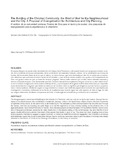El edificio de la comunidad cristiana, Palabra de Dios para el barrio y la ciudad: una propuesta de evangelización para la arquitectura y el urbanismo

Ver/
Use este enlace para citar
http://hdl.handle.net/2183/23061
A non ser que se indique outra cousa, a licenza do ítem descríbese como Atribución-NoComercial 4.0 España
Coleccións
Metadatos
Mostrar o rexistro completo do ítemTítulo
El edificio de la comunidad cristiana, Palabra de Dios para el barrio y la ciudad: una propuesta de evangelización para la arquitectura y el urbanismoTítulo(s) alternativo(s)
The building of the christian community, the word of God for the neighbourhood and the city: a proposal of evangelisation for architecture and city planningAutor(es)
Data
2003Cita bibliográfica
Zielinski, M. (2015). El edificio de la comunidad cristiana, Palabra de Dios para el barrio y la ciudad. Actas De Arquitectura Religiosa Contemporánea, 3, 268-277. https://doi.org/10.17979/aarc.2013.3.0.5079
Resumo
[Resumen] El espacio litúrgico no puede evitar dar testimonio del milagro de la Presencia, y sólo puede hacerlo por sus propios medios: a través de la evidencia de masas estructurales, de la combinación de materiales, texturas, colores; de la combinación armoniosa de formas; del movimiento fluido de la luz que la cubre y, al mismo tiempo, que está dominada por ella. Así se activa una comunicación silenciosa que conmueve el alma a través de los sentidos, y que, al tocar nuestro espíritu, nos ayuda a vivir la experiencia de Dios, nos gusta a todos los que, en todos los tiempos y lugares, hemos vuelto nuestros ojos al cielo, hemos elevado oraciones y hemos construido templos. Creo firmemente que esta vocación natural de la arquitectura litúrgica conserva su valor intacto incluso en la confusa configuración de la ciudad contemporánea, y que el espacio de la iglesia todavía debe esforzarse por responder a esa necesidad de lo sagrado que habita en cada uno de nosotros.
Esto no significa que tengamos que dar forma a proyectos más o menos audaces, intentando sugerir un vago misticismo o inducir una indefinida sugerencia emocional, sino que implica una investigación consciente y deliberada en los temas de arquitectura que durante siglos han sido capaces de darle al lugar de culto sus rasgos claramente vinculados a la persona de Cristo, a la teología de la revelación y a la historia de la salvación. [Abstract] The liturgical space cannot avoid testifying to the miracle of a Presence, and can only do so by its own means: through the evidence of structural masses, the combination of materials, textures, colours; the harmonious shape of forms; the fluid movement of light that covers it and, at the same time, is dominated by it. This activates a silent communication that stirs the soul through the senses, and that, by touching our spirit, helps us to live the experience of God, thereby making us like all those who, in all ages and places, have turned their eyes to heaven, have elevated prayers and built temples. I firmly believe that this natural vocation of liturgical architecture preserves its value intact even in the altered setting of the contemporary city, and that the church space should still strive to answer that need of the sacred that dwells in each of us. This does not mean shaping more or less bold prospects, intended to suggest a vague mysticism or induce an indefinite emotional suggestion, but it implies a conscious and deliberate inquiry into those architectural themes that for centuries have been able to give the place of worship traits clearly referable to the Person of Christ, to the theology of revelation, to the history of salvation
Palabras chave
Arquitectura religiosa
Arquitectura cristiana
Planificación urbana
Evangelización
La Palabra de Dios
Sacred architecture
Christian architecture
City planning
Evangelisation
The Word of God
Arquitectura cristiana
Planificación urbana
Evangelización
La Palabra de Dios
Sacred architecture
Christian architecture
City planning
Evangelisation
The Word of God
Versión do editor
Dereitos
Atribución-NoComercial 4.0 España
ISSN
2340-5503






